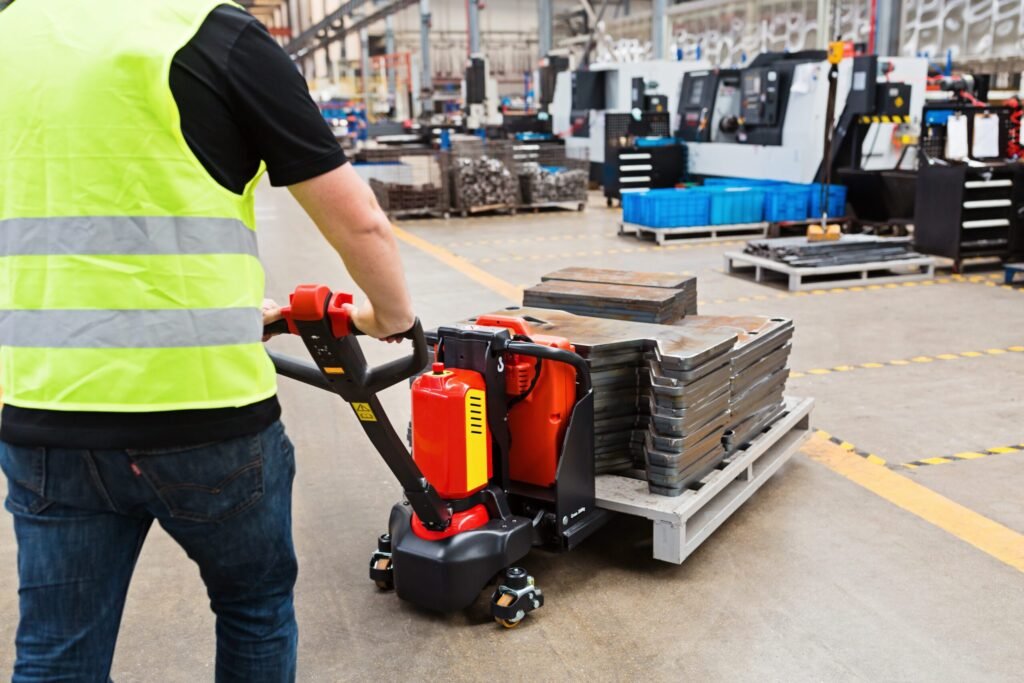As order profiles fragment and labour markets tighten, Australian operators have embraced conveyors, tilt-tray sorters, and cross-belt systems to automate repetitive transport tasks. A simple powered-roller conveyor can move cartons from receiving to decanting zones, eliminating manual push-trolleys and freeing staff for value-adding roles. At higher throughputs, modular plastic-belt conveyors navigate curves and inclines without product roll-back, while accumulation zones buffer cartons ahead of print-and-apply labelling stations. When volumes exceed 10 000 orders per shift, automated sorters route parcels to carrier lanes at speeds surpassing 7 000 units per hour, achieving error rates below 0.1 %. Australian businesses cite reduced overtime and improved dispatch cut-off times as the primary benefits, but automation also delivers a quieter working environment and predictable maintenance scheduling.
Safety Equipment: Barriers, Signage, and Personal Protective Gear
A single forklift-pedestrian collision can cost far more than any capital investment in safety infrastructure. Physical segregation remains the gold standard: steel safety barriers rated to withstand impacts of two tonnes at eight kilometres per hour protect walkways and packing areas, while pedestrian gates force staff to pause before crossing mobile-equipment lanes from plastics2go. Line-marked exclusion zones, floor-mounted bollards, and column protectors preserve building integrity during high-traffic manoeuvres. Inside cold-stores, anti-slip coatings and heated door seals prevent ice build-up, addressing a leading cause of slips, trips, and falls. Personal protective equipment—hard hats, steel-capped boots, and high-visibility clothing—is mandatory, but awareness signage and induction videos reinforce best practice. By embedding safety into equipment layouts from day one, businesses satisfy Work Health and Safety obligations and foster a culture where every team member speaks up about hazards.
Sustainability in Warehouse Equipment: From Power Sources to Recyclable Materials
Corporate responsibility statements are no longer PR exercises; they dictate procurement decisions. Lithium-ion forklifts eliminate lead-acid battery maintenance, cut charging times, and reduce electricity bills through regenerative braking. Solar panels on warehouse roofs offset conveyor and lighting power demands, while high-bay LED fixtures with motion sensors trim energy consumption during lulls. Equipment suppliers offer recyclable plastic pallet tubs and wrap-around packaging that replaces shrink film, diverting tonnes of single-use plastic from landfill each year. For Australian operations concerned about water scarcity, closed-loop floor-scrubber machines reclaim grey water on every pass. These sustainable choices often carry a lower total cost of ownership, supporting both environmental goals and the bottom line.
Future Trends: Robotics, AMRs, and AI in the Warehouse
Robotics is no longer the exclusive domain of multinational giants. Affordable AMR fleets, priced similarly to premium forklifts, perform zone-to-zone transfers 24 / 7, navigating mixed-traffic environments and auto-charging between tasks. Robotic palletisers and de-palletisers handle case stacks at the receiving dock, accelerating put-away and reducing manual strain injuries—the number-one claim category for Australian warehouse staff. Artificial intelligence systems crunch historical order data to predict SKU demand and dynamically allocate pick-faces overnight, ensuring fast movers are always positioned within the Golden Zone. Even maintenance is set for disruption, as AI-driven analytics platforms process millions of sensor readings to forecast bearing failures weeks in advance. While automation will never fully replace human ingenuity, its expanding role will recalibrate labour profiles toward supervisory, engineering, and analytical functions.
Conclusion: Investing Wisely in a Safer, Smarter Warehouse
Warehouse equipment underpins every carton dispatched, every pallet received, and ultimately every customer’s satisfaction. Australian businesses that align equipment choices with operational goals—whether that is rapid e-commerce fulfilment, temperature-controlled storage, or cross-docking bulk freight—gain the agility to navigate market swings and supply-chain shocks. By partnering with reputable local suppliers such as plastics2go and Castors2go, embracing smart technology, and embedding safety and sustainability into every purchase decision, organisations create warehouses that not only perform brilliantly today but remain adaptable for tomorrow. In a landscape where delivery windows shrink and expectations soar, the right equipment is no longer a cost centre; it is a competitive advantage that sets industry leaders apart.

